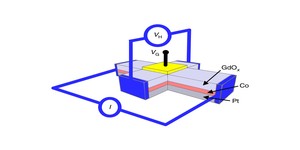IBM researchers boast of spintronics breakthrough
August 14, 2012 | 10:43
Companies: #eth-zurich #ibm #ibm-research

IBM has released details of a successful experiment resulting in the first ever direct mapping of the formation of a persistent spin helix in a semiconductor - a major step on the path to commercialising spintronic technology.
Spintronics, a portmanteau of 'spin,' 'transport' and 'electronics,' promises to revolutionise the semiconductor market. Spintronic components use the spin of the electron to store a zero or a one, rather than the charge of the electron. The result is the storage and transmission of data - and even calculations - with no energy dissipation, and a resulting reduction in the power required. Spintronic components would also blur the barrier between memory and storage, producing high-speed non-volatile storage which could easily be used as either memory or mass storage.
Sadly, spintronics is a technology which remains tantalisingly out of grasp, requiring several major breakthroughs before it can be commercially implemented. Chief among these was the problem of whether electron spins possessed the capability to preserve the encoded information long enough before rotating - a theoretical possibility, but one unproven.
Researches from IBM Research and the Solid State Physics Lab at ETH Zurich have now answered that question with a resounding 'yes,' in an experiment which lengthened the spin lifetime of electronics thirty-fold to 1.1 nanoseconds - a timescale handily compatible with the cycle of a 1GHz processor.
The breakthrough, IBM's Gian Salis explains, came from an observation that electron spins move in a manner similar to dancers in the Viennese waltz - shifting tens of micrometres in a semiconductor with their orientation rotating along the path in perfect synchronisation.
'If all couples start with the women facing north, after a while the rotating pairs are oriented in different directions,' Salis explains of his group's discovery. 'We can now lock the rotation speed of the dancers to the direction they move. This results in a perfect choreography where all the women in a certain area face the same direction. This control and ability to manipulate and observe the spin is an important step in the development of spin-based transistors that are electrically programmable.'
Using short laser pulses to monitor the evolution of thousands of electron spins created simultaneously in a very small spot on a gallium arsenide semiconductor, IBM researchers were able to observe a persistent spin helix - a stripe-like pattern key to the success of spintronics and originally theoretically proposed back in 2003 but never before directly observed.
Sadly, despite representing a major breakthrough in the field, spintronics remains a lab-based pursuit: IBM warns that its experiments took place at a temperature of 40 Kelvin, or -233 degrees Celsius - something even the most impressive off-the-shelf liquid cooling system is unlikely to achieve in commercial devices.
The team's research has been published in the journal Nature Physics.
Spintronics, a portmanteau of 'spin,' 'transport' and 'electronics,' promises to revolutionise the semiconductor market. Spintronic components use the spin of the electron to store a zero or a one, rather than the charge of the electron. The result is the storage and transmission of data - and even calculations - with no energy dissipation, and a resulting reduction in the power required. Spintronic components would also blur the barrier between memory and storage, producing high-speed non-volatile storage which could easily be used as either memory or mass storage.
Sadly, spintronics is a technology which remains tantalisingly out of grasp, requiring several major breakthroughs before it can be commercially implemented. Chief among these was the problem of whether electron spins possessed the capability to preserve the encoded information long enough before rotating - a theoretical possibility, but one unproven.
Researches from IBM Research and the Solid State Physics Lab at ETH Zurich have now answered that question with a resounding 'yes,' in an experiment which lengthened the spin lifetime of electronics thirty-fold to 1.1 nanoseconds - a timescale handily compatible with the cycle of a 1GHz processor.
The breakthrough, IBM's Gian Salis explains, came from an observation that electron spins move in a manner similar to dancers in the Viennese waltz - shifting tens of micrometres in a semiconductor with their orientation rotating along the path in perfect synchronisation.
'If all couples start with the women facing north, after a while the rotating pairs are oriented in different directions,' Salis explains of his group's discovery. 'We can now lock the rotation speed of the dancers to the direction they move. This results in a perfect choreography where all the women in a certain area face the same direction. This control and ability to manipulate and observe the spin is an important step in the development of spin-based transistors that are electrically programmable.'
Using short laser pulses to monitor the evolution of thousands of electron spins created simultaneously in a very small spot on a gallium arsenide semiconductor, IBM researchers were able to observe a persistent spin helix - a stripe-like pattern key to the success of spintronics and originally theoretically proposed back in 2003 but never before directly observed.
Sadly, despite representing a major breakthrough in the field, spintronics remains a lab-based pursuit: IBM warns that its experiments took place at a temperature of 40 Kelvin, or -233 degrees Celsius - something even the most impressive off-the-shelf liquid cooling system is unlikely to achieve in commercial devices.
The team's research has been published in the journal Nature Physics.

MSI MPG Velox 100R Chassis Review
October 14 2021 | 15:04








Want to comment? Please log in.